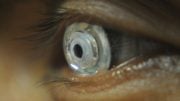
Cataracts are the clouding of the lens of your eye and can currently only be cured through surgery. However, recent extremely positive lab results give hope that the condition might soon be able to be treated with just drugs.
Anglia Ruskin University expert leads work on an anti-cataract drug, which shows promising results in lab tests
Currently, cataracts can only be cured with surgery. However, a groundbreaking new treatment for cataracts has had incredibly positive laboratory test results suggesting that the affliction might soon be able to be treated with drugs.

Barbara Pierscionek, the Deputy Dean of the Faculty of Health, Education, Medicine, and Social Care at Anglia Ruskin University, and co-author of the study. Credit: Anglia Ruskin University
The study’s results were published on May 2nd, 2022 in the peer-reviewed journal Investigative Ophthalmology and Visual Science.
A cataract is a clouding of the eye lens that develops over time and compromises the quality of vision. It is caused by a disorder of the proteins in the lens that leads to clumps of protein accumulating that scatter light and substantially limit transmission to the retina. The National Eye Institute estimates that cataracts impact an estimated 24.4 million Americans age 40 or older.
Nuclear sclerotic, cortical, and posterior subcapsular cataracts are the three main types of cataracts.
A team of international scientists, led by Professor Barbara Pierscionek, Deputy Dean (Research and Innovation) in the Faculty of Health, Education, Medicine and Social Care at Anglia Ruskin University, have been carrying out advanced optical tests on an oxysterol compound that had been proposed as an anti-cataract drug.
In laboratory trials, treatment with the oxysterol compound VP1-001 showed an improvement in refractive index profiles – a key optical parameter that is needed to maintain high focusing capacity – in 61% of lenses. This means that the protein organization of the lens is being restored, resulting in the lens being better able to focus. This was supported by a reduction in lens opacity in 46% of cases.
Professor Pierscionek, who is also a member of the Medical Technology Research Centre at Anglia Ruskin University (ARU), said: “This study has shown the positive effects of a compound that had been proposed as an anti-cataract drug but never before tested on the optics of the lens. It is the first research of this kind in the world.
“It has shown that there is a remarkable difference and improvement in optics between eyes with the same type of cataract that was treated with the compound compared to those that were not.
“Improvements occurred in some types of cataracts but not in all indicating that this may be a treatment for specific cataracts. This suggests distinctions may need to be made between cataract types when developing anti-cataract medications. It is a significant step forward towards treating this extremely common condition with drugs rather than surgery.”
Reference: “Oxysterol Compounds in Mouse Mutant αA- and αB-Crystallin Lenses Can Improve the Optical Properties of the Lens” by Kehao Wang, Masato Hoshino, Kentaro Uesugi, Naoto Yagi, Barbara K Pierscionek and Usha P Andley, 2 May 2022, Investigative Ophthalmology & Visual Science.
DOI: 10.1167/iovs.63.5.15









This is great achievement how long after taking the anti- cataract drug the eyes visions can be improve?